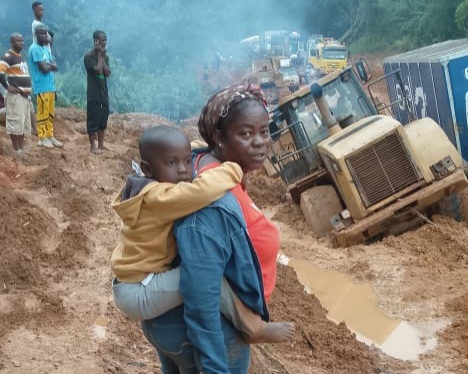MONROVIA – In the heart of Liberia lies a tragic tale of neglect and abandonment—a major highway that once pulsated with life and connectivity, now reduced to a harrowing stretch commonly referred to as the “Road to Hell.” Liberian journalist Lyndon Ponnie, Sr., reports on how this nightmare has become a symbol of despair for approximately one million residents of Southeastern Liberia, who find themselves isolated and forgotten by their own government.
Under the leadership of former President George Weah, the hopes of many citizens in the Southeast rested on the promise of improved infrastructure, particularly the main road leading into their region. Supporters believed that Weah, as a native son, would prioritize their needs. However, time has shown this faith to be misplaced. Despite assurances from then Public Works Minister Mobutu Vlahn Nyanpan—who declared that funding was secured and work would commence with the dry season—the reality is starkly different. Tragically, Nyanpan’s untimely death under mysterious circumstances left the project stranded in limbo, causing the Southeast to slip further into obscurity.
The government’s focus shifted toward Nimba and Lofa counties, perceived as more politically advantageous due to their higher voter populations. In this quest for reelection, the Southeast has been left behind, with its citizens bearing the brunt of this neglect. As Joseph Boakai narrowly defeated Weah in the recent presidential elections, the people look to him for rescue, as his campaign embraced the mantra of a “Rescue Mission.” Historically, the region experienced some level of access during the administrations of William R. Tolbert and Ellen Johnson Sirleaf, though the highway was never paved. Today, the situation has deteriorated beyond recognition.
Imagine traversing a once-bustling highway, now a nightmare of jagged rocks and deep ruts. Potholes large enough to swallow trucks litter the path, transforming it into a perilous obstacle course for those daring enough to navigate its treacherous landscape. The edges of the road are overrun with weeds, a stark contrast to the well-maintained thoroughfare of the past. Dust clouds rise with every passing vehicle, obscuring visibility and coating everything in a fine layer of grit during the dry season. In the rainy season, the road becomes a muddy quagmire, rendering even the sturdiest vehicles helpless against the relentless grip of sludge. Currently, the road is nearly impassable.
Minimal and often illegible signage adds to the confusion, forcing drivers to navigate the hazardous route by guesswork. The lack of maintenance and construction has created an environment characterized by sharp turns and blind spots, catching even the most cautious drivers off guard. This road, meant to connect towns, cities, communities, and even neighboring Ivory Coast, instead isolates them—a grim testament to decades of neglect.
The people of Southeastern Liberia acutely feel the weight of this abandonment. They remain confined to their region, unable to benefit from the resources and taxes generated there while the central government turns a blind eye. The dreams of a better future, once nurtured by promises of development, now lie shattered on the crumbling and dilapidated “Death Road.” Several individuals have died and been injured in motor accidents, yet the central government has taken no action.
As the people of Southeastern Liberia grapple with this harsh reality, one question looms large: Who will rescue them from this nightmare? Abandoned by their own sons and daughters in successive governments, the need for urgent action is clear. The cries for help echo through the desolate landscape. It is time for the government to acknowledge the plight of its citizens and take meaningful steps toward rebuilding not only the road but also the trust that has been lost along the way.
The Southeast deserves better; it is time for action, not just words. As President Joseph Boakai takes office, he must seize this opportunity to turn the tide and respond to the suffering of this region, irrespective of political differences. The people of Southeastern Liberia are waiting for a leader who will prioritize their needs and restore hope to their forgotten communities.

